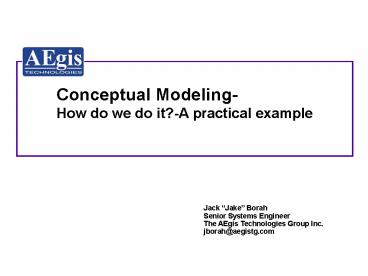HLA Policy and Process Training Module - PowerPoint PPT Presentation
1 / 14
Title:
HLA Policy and Process Training Module
Description:
The AEgis Technologies Group Inc. jborah_at_aegistg.com. Where Do We Go Now? ... Jake Borah and team from AEgis Technologies. What was modeled? ... – PowerPoint PPT presentation
Number of Views:24
Avg rating:3.0/5.0
Title: HLA Policy and Process Training Module
1
Conceptual Modeling- How do we do it?-A
practical example
Jack Jake Borah Senior Systems Engineer The
AEgis Technologies Group Inc. jborah_at_aegistg.com
2
Where Do We Go Now?
- Limited of Authoritative Reference Material on
how to do Conceptual Modeling as a part of
Simulation Development - Conceptual Modeling is not a term discussed in
modeling and simulation textbooks - Web searches on Conceptual Modeling have led to
a diverse set of web sites that contributed
little if anything the body of knowledge - Most often Conceptual Modeling was in relation
to Database Modeling
3
The Answer- A SISO Study Group
- The audience feedback from the Spring SIW paper
was that a Study Group was needed - SISO Policies and Procedures states that the
EXCOM may establish Study Groups to consider
specific issues and to provide recommendations
concerning proposed courses of action - Study groups shall operate under specific Terms
of Reference that identify the issues and the
specific questions that need to be addressed.
4
Where we are now
- The Terms of Reference have been approved for a
Simulation Conceptual Model Study Group - The First Meeting is now
- One of the first actions is to perform a data
call for relevant conceptual modeling experiences - The presentation of this paper is an initial
response
5
What we want to know about the Conceptual Modeling
- Who did the modeling?
- What was modeled?
- How is was modeled?
- Why it was modeled?
- What was learned?
6
A Ballistic Missile HWIL Simulation
- Who did the modeling? Jake Borah and team from
AEgis Technologies - What was modeled? The System Representational and
Executive Components - How is was modeled? In an evolutionary manner
being with a customer suggested tabular format
and progressing to Rational Rose UML models - Why it was modeled? The customer wants to use
conceptual models to manage future simulation
system requirements
7
A Ballistic Missile Parallel Discrete Event
Simulation
- Who did the modeling? Jake Borah and team from
AEgis Technologies - What was modeled? The System Representational and
Executive Components - How is was modeled? In an evolutionary manner
being with a customer suggested tabular format
and progressing to Rational Rose UML models - Why it was modeled? The customer wants to use
conceptual models to manage future simulation
system requirements
8
What was Learned?
- Conceptual Model Requirements must be set early
- No single customer
- Simulation Product Leads vs VVA advisors
- Diverse requirements for CM
- Requirement to have a CM set by sponsor but
imprecisely defined for customer - CM to be used as part of future requirements
management process - CM needed to reflect existing simulation
- The Why, without being the How.
9
What was Learned?
- Conceptual Model Development Process must be
defined - Customer has no standing development process
- Developer using iterative (breadth then depth )
process to refine customer requirements and
obtain customer buy-in a - Review and comment problematic
- Drafts submitted
- Little or no constructive feedback provided
10
What was Learned?
- Developer must educated Customer on CM
- Vague guidance on Product format
- Tabular, Document, UML model
- Unrealistic specification of CM tools
- Compatible with Office suite
- Unrealistic expectations of time and resources
required - Initially customer specified legacy system fast
as possible - Shifted to next generation of MS requirements as
fast as possible - Now when possible for legacy system
11
Tabular Model
12
Document Format
13
UML Diagram
14
Conclusions
- Reverse Engineering a legacy model is deceptively
hard - Attempted due to the false assumption that
adequate and credible documentation exists - Violate Basic Systems Engineering Practices at
your own considerable Risk! - Product Requirements Management
- Customer Expectations and Buy-in































